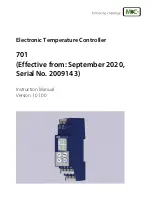
CAEN
Electronic Instrumentation
UM6508
–
DT5495 User Manual rev. 0
35
9
Software Interface
The DT5495 board can be accessed via both Ethernet and USB interface. All registers are accessible from both
communication interfaces.
9.1
Address Map
The following table illustrates the DT5495 address map:
Address
Description
0x0000-0x0FFF
UFPGA data access
0x1000-0x7FFF
UFPGA register access
0x8000-0x80FF
reserved
0x8100-0x81FF
Configuration ROM
0x8200-0x83FF
Configuration and Status Registers
0x8400-0x84FF
Reserved
0x8500-0x86FF
MFPGA flash configuration
0x8700-0x88FF
UFPGA flash configuration
0x8900-0x8AFF
GDG flash configuration
0x8B00-x8BFF
Reserved
0x8C00-0x8FFF
Internal scratch RAM
0x9000-0xFFFF
reserved
Tab. 9.1:
DT5495 register address map
User FPGA Data Access (0x0000-0x0FFF)
The UFPGA data access space is allocated specifically for the readout of data produced in the UFPGA logic which need
to exploit the maximum readout throughput available. This space can be accessed by using the available block transfer
mechanism over the Ethernet or USB communication interfaces.
Block data transfer allows to implement a faster readout. Block transfers requests over Ethernet or USB do not trigger
any transfer over the internal local bus between the MFPGA and UFPGA: a data prefetch mechanism, implemented in
the MFPGA, stores User data into a local data queue (prefetch data queue). Please, refer to the prefetch mechanism
description in Sect
Local Bus Interface
. Consequently, data from the UFPGA data access space are read from the
prefetch data queue in the MFPGA.
User FPGA Register Access (0x1000-0x7FFF)
UFPGA register address range is allocated for User register read/write.
A read or write transfer (single cycle) can be triggered on the local bus by performing a corresponding read transfer in
the 0x1000-0x7FFF address interval.
The local bus master in the MFPGA acts as a transparent bridge between the communication interface (ETH/USB) and
the local bus in this interval. A couple of examples are given to illustrate the transparent bridge behaviour.
















































